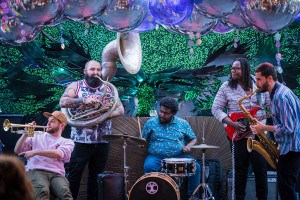ALBUM REVIEW: 1000 Forms of Fear Proves Sia is the True Elusive Chanteuse
Sia Furler is the anti-Perry: The personally understated Australian singer-songwriter shrouds her face with a brown paper bag, seldom tours, once demanded she not be credited for writing Flo Rida’s “Wild Ones” and, if you can believe it, managed to iron out a clause in her RCA recording contract that gives her the OK to bypass all promotion for her sixth studio LP, 1000 Forms of Fear (out July 8). The message is loud and clear: Fame just ain’t her thing. She wouldn’t be caught dead in any variant of Perry’s strobe-lit arenas, those engorged by angst-swollen tweens screaming for a flickering moment of attention while paparazzi snap-snap away.
Which begs a certain question: Why is the fame-frightened Furler making the promotional rounds—albeit, using a blonde-bobbed, dancing doppelganger as her scapegoat—on Jimmy Kimmel,Seth Meyers (accompanied by center-of-the-universe Lena Dunham, no less) and Ellen?
No guesses? I’ll tell you upfront: Because the album is damn good. It’s worth crooning out a tune or two on late-night at the risk of suffering spotlight-anxiety, and praise The Headless Bob that she woke up to that little fact before this gem got swept into the dustbin of obscurity.
1000 Forms of Fear opens with tone-setter and on-the-brink chart hit “Chandelier.” True to the songwriter’s pick-an-object-and-write-about-it songwriting method (see: “Perfume,” “Diamonds” and “Blank Page,” to cite a few), the album’s lead single remains the most resonant metaphoric power ballad this side of “Wrecking Ball,” with a glass-shattering chorus and appreciable (but not shoe-horned) undertones of hip-hop.
But let’s pause for a moment: “Chandelier” isn’t just an intro to the album, it’s a re-introduction—and first-time introduction, to many in the U.S.—to Sia the Artist, pop music’s (actual) elusive chanteuse—the woman who is, at present, better known for scribbling ambiguities to the tune of lyric-vacant beats and warbling a few notes into a mic as a guidepost for whichever A-list diva snatches up her shell of a song. All, of course, to make a buck and score the premier pop girls a chart-buster.
Said Furler to the New York Times Magazine in March: “I can’t believe I got away with it”—to be clear, referring to the fact that she’s raked in enough songwriting royalties from cliché power-ballads to afford an upgrade from … well, titanium to platinum. One might assume, then, that a Sia album would be full of these hollow, cash-in, bang-you-over-the-head metaphors that have made her so much mula since 2010.
Wrong.
Instead (thank goodness), Sia envelops listeners with a soul-wrangler of an LP, flourished with all sorts of vocal tics and lyrical punches. She transitions from “Chandelier” right into a follow-up emotional whopper: “Big Girls Cry” is—I’d speculate—a no-apologies counter to the Fergie Subscription to womanhood and conjures a “that’s-so-true” image of weeping in front of the TV with a filled-to-the-brim glass of champagne. I may cry, ruining my makeup / Wash away all the things you’ve taken / I don’t care if I don’t look pretty / Big girls cry when their hearts are breaking, she declaratively sings. The emotional wave goes full-on tsunami by the time “Eye of the Needle” arrives, which thematically tackles the ambivalence of moving on from love and sonically peaks with a screeching bridge-to-chorus payoff that feels like her voice is about to rip to shreds—as if pained by the lifting of an anchor from the ocean floor.
Rounding out the ballad portion of the experience is the haunting, heart-thumping production of “Cellophane” (read: anthem for the neurotic) and the overwrought “Fire Meets Gasoline,” the latter a lyrically clever song marred by its melodic likeness to Beyoncé’s “Halo” and Kelly Clarkson’s “Already Gone.” Marry these ballads with the empowering and fragile (it’s somehow both) electro-R&B of “Elastic Heart,” the sedated bloodthirst of “Straight for the Knife” and the moody-but-freeing vibes of album-closer “Dressed in Black,” and it’s a musical highway paved with liberation and torment with few rest stops in between.
But there are exceptions (aren’t there always?): “Burn the Pages,” a feel-good “fuck-it,” sweetens an oft-salty set with optimism while simultaneously feeling like a song that lost its way on the path to a Natasha Bedingfield album. The same applies to the excellent, if unintelligible, “Hostages.”
https://www.youtube.com/watch?v=5Kw_R7h7MNE
What’s most uncanny, however, is that despite 12 cohesively dark tracks’ worth of crowing and belting and bellowing and shrieking and cracking, there’s still a sense that Sia herself just doesn’t know how to feel. But that’s where the album—perhaps unintentionally, I’ll admit—evokes its aha! moment: Life is a cluster of experiences that at once makes us want to skip gaily down the sidewalk and wallow on a street corner. And the truth of it is that, in these moments, we never really know whether to pop a Xanax or bear the pain with a grinning tear of our mimetic muscles. Which is to say that, nascent in the lyrics and sonic color of the album, is the notion that we may all be a little elusive—unready and unwilling to surface from the shadows until we’re just a little more sure of ourselves.
There’s a scene from The Golden Girls (yes, I’m going to quote The Golden Girls) where Blanche Devereaux describes these seemingly indescribable feelings as being in a state of “magenta”—feelings so conflicted with one another that they’re neither blue nor yellow. This is, in fact, an apt way of describing the shapes and sounds of Sia’s latest endeavor: 1000 forms of fear; 12 shades of magenta.
Ranking: 1000 Forms of Fear snags four headless bobs out of five
Download: “Eye of the Needle,” “Big Girls Cry,” “Elastic Heart,” “Chandelier”


